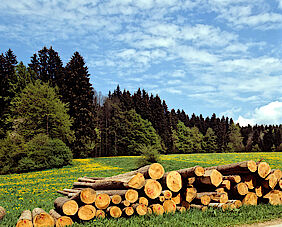Publications
The EU’s renewable energy ambitions: Bioenergy from forests is not always carbon neutral - and may even increase the EU’s carbon emissions
Since the launching of the EU’s clean energy package in November 2016, the European institutions and many Member States have emphasised their renewable energy ambitions, which culminated in political agreement on the recast of the renewable energy directive on 14 June 2018. During the past year, EASAC has worked to draw the attention of policy makers to a glaring oversight in this ambition: the EU and its Member States continue to classify all biomass from forests as carbon neutral, renewable energy. It is simplistic and misleading to classify all types of biomass from forests as sources of carbon neutral renewable energy as explained in the European Academies’ Science Advisory Council (EASAC) report published in April 2017.
Today, EASAC is releasing a commentary to re-emphasise its original points and to strongly encourage policy-makers to reconsider their approach to the use of forest biomass for energy. Whilst it may be too late to change the text of the directive itself, policy makers in the Member States could and should implement it in ways which reflect these scientific realities, and which will contribute positively to their commitments to the Paris Agreement.
It is often claimed that the carbon released by burning wood and other forest biomass is removed from the atmosphere when the vegetation grows back. This may be true in the long term, but policy-makers may not realise how much time is needed for this to happen. At the very least, it takes many decades, and in some cases, it will take hundreds of years for the carbon to be absorbed by new vegetation. In the meantime, the released carbon will contribute to climate change just as much as burning coal or oil.
The carbon neutrality argument – that the carbon dioxide emitted when biomass is burnt is fully compensated for by uptake of carbon dioxide from the atmosphere due to plant growth – has given a strong boost to policies that aim to increase the use of forests as a source of bioenergy and as a substitute for fossil energy. Forest biomass is classified as renewable, and currently contributes substantially to the EU’s renewable energy targets. However, in reality, carbon emissions per unit of electricity generated from forest biomass are higher than from coal. In addition, when one harvests trees that have a large, ongoing carbon storage potential, then the emissions from burning the biomass are associated with the loss of a carbon sink, and the net effect on the climate is likely to be negative.
The oversimplified concept of carbon neutrality leads many to think that use of biomass is automatically ‘renewable’ and can be counted towards GHG emission reduction targets on an equal level with wind and solar. Achieving carbon neutrality involves potentially long time periods and, in the context of the timescales relevant to Paris Agreement commitments, climate impacts range from positive to negative depending on the nature of the forest biomass used and post-harvest land use. Climate impacts from using forest biomass for energy must therefore be considered on a case-by-case basis together with the sustainability of forestry in EU climate and energy policy.
“There are significant dangers of shooting ourselves in the climate foot if we do not differentiate effectively between climate positive and climate negative uses of forest biomass”, said Professor Michael Norton, EASAC’s Environment Programme Director.
“As our recent report on negative emissions has shown, we are already in danger of not meeting the Paris Agreement targets. If the EU and Member States continue to count all forest biomass as renewable energy, and not validate their climate impacts on a case-by-case basis, we may even be increasing the EU’s carbon emissions through our ‘renewable’ energy policies”, he added.
“Renewable energy policies in the European Union are increasingly ambitious, which is a positive trend. But policy-makers must ensure that renewable energy is truly renewable within the relevant policy timeframe. Bioenergy from forest biomass with long carbon payback periods is not renewable in the context of the EU’s Paris commitments,” noted Dr. William Gillett, EASAC’s Energy Programme Director.
ENDS
Notes for editors:
In April 2017, the European Academies Science Advisory Council (EASAC) published its major review of Multi-functionality and Sustainability in EU forests, which examined the policy implications of the increasing demands and expectations being placed on the limited forest resource in the EU. While the report covered a number of issues (including biodiversity and forest management strategies), the last year has seen most attention given to the question of how far forest biomass should be regarded as a source of ‘renewable’ energy and allowed to contribute to Member States’ emission reduction targets (and treated equally with solar, wind etc.).
The EASAC report showed that while some types of forest biomass (typically forest industry wastes and thinnings) could contribute to climate change mitigation, many options (especially those involving increased harvesting of mature trees) could have a significantly negative effect on climate change over extended periods, and therefore perverse outcomes from renewable energy policies which incentivise expanded use of forest biomass.
In the new commentary, EASAC points out that in the year which followed our report, EASAC experts have engaged with the Commission, the Parliament and other stakeholders on the science underlying the use of forest biomass within the debate and negotiations on the ‘Clean energy for all Europeans’ package. In these discussions, the concept of ‘carbon neutrality’ was frequently invoked to justify the increased use of all kinds of biomass, including forest biomass, without recognising the inherent weaknesses of the concept.
In view of the political agreement on the recast of the renewable energy directive, which was reached on 14 June, EASAC has decided to issue this short commentary re-emphasising the potential perverse effects of the over-simplified use of the carbon neutrality concept. It is hoped that this commentary will inform policy makers in the Member States and encourage them to implement the recast renewable energy directive in ways which fully reflect the scientific facts. In particular, national regulations should ensure that incentives are limited to forest biomass with short carbon payback times, such as wastes and thinnings which can be shown to deliver positive contributions to climate change mitigation in the short periods relevant to achieving the Paris Agreement targets.
Further resources
Multi-functionality and Sustainability in the European Union's Forests, EASAC, April 2017 (Flipbook version)
About the European Academies’ Science Advisory Council (EASAC)
EASAC is formed by the national science academies of the EU Member States, Norway, and Switzerland, to collaborate in giving advice to European policy-makers. EASAC provides a means for the collective voice of European science to be heard. Through EASAC, the academies work together to provide independent, expert, evidence-based advice about the scientific aspects of European policies to those who make or influence policy within the European institutions.
Contact information






























